
Vol. 15 No. 2 |
Fall 2005 |
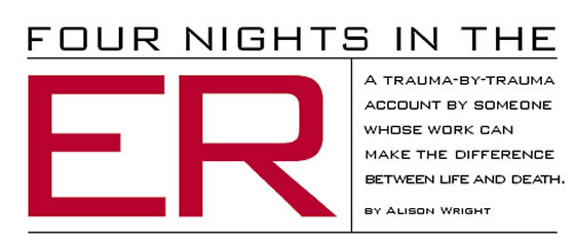
ER Alison Wright has been a nurse for more than 20 years. She works in the Emergency Department at the University of Utah Hospital on the “swing shift,” from 1 p.m. to 1 a.m.—the busiest 12 hours of the day for the department. For a few days, she recorded some of her experiences.
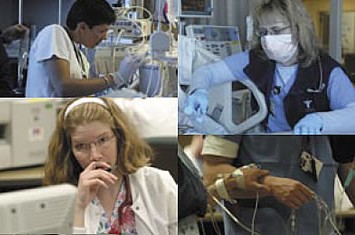 I
have 10 minutes to prepare for the “Trauma I” arriving via
Air Med. A Trauma I case is the most serious, and the Emergency Department
begins buzzing. A young man has rolled his ATV. Reports coming in say
that he was traveling at a high speed and was not wearing a helmet, so
we are bracing for the worst. He is wheeled in off the helicopter, not
responding. Blood flows out of his ears. We put a tube down his trachea
to help him breathe. He has air and blood competing for the space that
his lungs need, and so we place chest tubes to remove the excess air and
fluid. The Computed Tomography (CT) of his head shows severe injury to
the brain, and we admit him to the Neuro Critical Care Unit and leave
him in the capable hands of the team there. Afterward, I wonder why he
wasn’t wearing a helmet, and think about him—someone’s
son—fighting for his life.
I
have 10 minutes to prepare for the “Trauma I” arriving via
Air Med. A Trauma I case is the most serious, and the Emergency Department
begins buzzing. A young man has rolled his ATV. Reports coming in say
that he was traveling at a high speed and was not wearing a helmet, so
we are bracing for the worst. He is wheeled in off the helicopter, not
responding. Blood flows out of his ears. We put a tube down his trachea
to help him breathe. He has air and blood competing for the space that
his lungs need, and so we place chest tubes to remove the excess air and
fluid. The Computed Tomography (CT) of his head shows severe injury to
the brain, and we admit him to the Neuro Critical Care Unit and leave
him in the capable hands of the team there. Afterward, I wonder why he
wasn’t wearing a helmet, and think about him—someone’s
son—fighting for his life.
I am asked to take the blood pressure of a rape victim. She does not want to be touched by her male nurse … or any other male. I find her curled up in a ball in the corner of the room. I speak to her calmly and tell her what I am going to do, and I reassure her that I will be very gentle. Her physical vital signs are all within normal limits. But the other thing—the emotional and psychological pain—is beyond what I can help her with.
A college student, “Paige,” is carried into the Emergency Room by her friends. Paige is pale and has the sheet pulled up to her nose. She looks away when I ask her questions. Her friends are very concerned and say that Paige has been refusing to eat and has lost more than 20 pounds. They don’t know what to do, and her family lives out of town. Paige does not want them to be notified—she’s adamant about that. I presume this is not the first time that she has had to deal with anorexia. I understand that she is very worried about being heavy, although she is painfully thin. When I start the IV, she wants to make sure that the fluid does not contain any sugar.
Tuesday
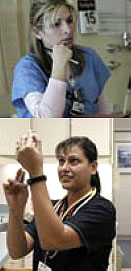 Another
trauma today. Emergency medical services reports that they are bringing
in a gentleman who was in a collision. Thank goodness he’d been
wearing a seatbelt. Apparently, he hit a moose. He complains of neck pain
and has sustained multiple abrasions. A CT of the neck and spine reveals
a fracture, so he’s admitted to the hospital. I guess the moose
didn’t do quite as well. I have a bit of time with the patient before
his room is ready. We sit there while he talks about his daughter and
tells me how bad he feels that the moose died. An elderly gentleman is
brought in by his children. This guy cracks me up. He had fainted at home,
and his daughter insisted that he come to the Emergency Department to
be evaluated. He says he doesn’t have time for this “nonsense”
because he needs to get home to give his wife her evening medications.
He’s one of those old guys who is full of life, who will probably
keep going until he’s 103. After a while, he agrees that he isn’t
“indispensable” and that his grown children are up for the
medication challenge. He jokes about his pacemaker, pokes at his chest,
and says, “The doctor told me I had a big heart. I told him there
are some people who would strongly disagree with him!”
Another
trauma today. Emergency medical services reports that they are bringing
in a gentleman who was in a collision. Thank goodness he’d been
wearing a seatbelt. Apparently, he hit a moose. He complains of neck pain
and has sustained multiple abrasions. A CT of the neck and spine reveals
a fracture, so he’s admitted to the hospital. I guess the moose
didn’t do quite as well. I have a bit of time with the patient before
his room is ready. We sit there while he talks about his daughter and
tells me how bad he feels that the moose died. An elderly gentleman is
brought in by his children. This guy cracks me up. He had fainted at home,
and his daughter insisted that he come to the Emergency Department to
be evaluated. He says he doesn’t have time for this “nonsense”
because he needs to get home to give his wife her evening medications.
He’s one of those old guys who is full of life, who will probably
keep going until he’s 103. After a while, he agrees that he isn’t
“indispensable” and that his grown children are up for the
medication challenge. He jokes about his pacemaker, pokes at his chest,
and says, “The doctor told me I had a big heart. I told him there
are some people who would strongly disagree with him!”
Wednesday
Today a middle-aged woman comes in with severe nausea and vomiting. She’s been sick for three days with a viral gastrointestinal “flu.” I tell her that she is going to love me in 20 minutes, and give her IV fluids and medication for her pain and nausea. This is one of my favorite things, to be able to give patients comfort and make them feel better so quickly. It doesn’t happen very often, and it’s a nice break from all the serious cuts, crashes, and broken bones. By the time she goes home, she is my best friend!
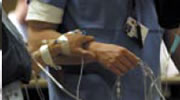 One
of our medical staff has dislocated his finger climbing. His treatment
includes two trips to radiology, a finger block, and a splint. He’s
in and out of the Emergency Department in 40 minutes. I ask our doctor
if I would receive similar VIP treatment. “Of course!” he
says, then smiles. Not sure if I believe him, but I’m not about
to dislocate my finger to find out.
One
of our medical staff has dislocated his finger climbing. His treatment
includes two trips to radiology, a finger block, and a splint. He’s
in and out of the Emergency Department in 40 minutes. I ask our doctor
if I would receive similar VIP treatment. “Of course!” he
says, then smiles. Not sure if I believe him, but I’m not about
to dislocate my finger to find out.
When I spot his Stetson and cowboy boots I know I’m in trouble. Cowboys are tough. They’ve got an inner strength that bowls me over. Apparently, this old wrangler has had a backache that just wouldn’t go away. After much deliberation he went to his local clinic, and the staff there decided to x-ray his back to see if it would shed any light on his problem. The X ray revealed a possible abdominal aortic aneurysm, where there is a weakness or “ballooning” of the aorta. If it ruptures, he could bleed to death in a minute. Air Med, the helicopter transport team, was notified, and he was immediately brought to our Emergency Department. The vascular team meets him in Emergency and accompanies him to the CT scanner, which provides more specific and detailed diagnostic information. He indeed has a huge aneurysm. The team immediately rushes him up to the operating room to place a graft in the affected area of the aorta. Although the cowboy is informed of his grave condition, he remains cool and calm about the whole situation, unlike his poor nurse. It’s like he’s seen everything in his long life, and one more little hiccup doesn’t surprise him much.
Thursday
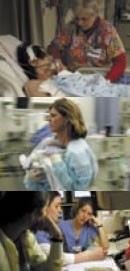 A
young woman was driving her friend’s scooter and ran into the back
of a parked car. She flew over the handlebars and hit the ground headfirst.
Her friends state that she “passed out” for a few seconds.
By the time she arrives in the Emergency Department she is awake and embarrassed.
She refuses treatment because she doesn’t have insurance and she
feels fine. All I can do is tell her to wear a helmet and look where she’s
going. I think back to the poor kid who had the ATV accident earlier in
the week.
A
young woman was driving her friend’s scooter and ran into the back
of a parked car. She flew over the handlebars and hit the ground headfirst.
Her friends state that she “passed out” for a few seconds.
By the time she arrives in the Emergency Department she is awake and embarrassed.
She refuses treatment because she doesn’t have insurance and she
feels fine. All I can do is tell her to wear a helmet and look where she’s
going. I think back to the poor kid who had the ATV accident earlier in
the week.
A woman in her 40s comes in with chest pain. She and her husband are very upset and crying because three days ago she had a heart attack. Her cardiologist had found two areas of blockage in a large artery, and had inserted two tubes—or stents—to keep the artery open. She thought that would be the end of her “nightmare,” that she would be healthy again. But today she is experiencing the same type of pain she had before the surgery, and the nitroglycerin pills she took at home didn’t help. Following her tests the cardiologist informs her that she needs to return to the cath lab for further evaluation. She is terrified, her voice shakes and tears fill her eyes. I sit with her for a while and we talk about the wonders of modern technology, all the things that medicine can do. I confide that my husband also had a procedure like hers when he was young, and he’s doing great. Sometimes, you have to share a little bit of yourself to help others through their dark moments. She hugs me as they wheel her upstairs for the procedure. I watch her go, and I take a couple of deep breaths before turning back to my work.
Photos by the Documentary Group